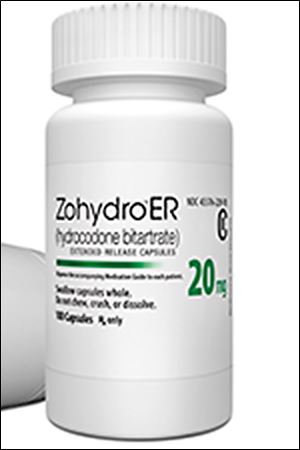
EDITORIAL
Enough
Zohydro has potential benefits, but now is not the time for another addictive painkiller in Ohio
5/11/2014
Sprague

Sprague
In making and marketing a powerful new painkiller called Zohydro, Zogenix Inc. of California did what pharmaceutical companies should do: create a profitable product that could benefit consumers.

Kasich
But in approving Zohydro last October, the U.S. Food and Drug Administration shirked its broader responsibility to the public. It aggravated the risks of addiction in the midst of a nationwide opioid and heroin epidemic. And it sent the wrong message to doctors and other prescribers, many of whom don’t fully understand how addiction works or the potential for abuse in the painkillers they prescribe.
Click here to read more Blade editorials.
Rejecting a recommendation from its advisory panel, the FDA left states already dealing with an addiction crisis scrambling to control another potent painkiller.
A bill sponsored by state Rep. Robert Sprague (R., Findlay) would reclassify Zohydro as a Schedule 1 drug, making it as illegal as heroin. Mr. Sprague acknowledged that his bill, if approved, could face a court challenge.
But lawmakers and Gov. John Kasich must seek ways to ban or restrict Zohydro, at least until the manufacturer develops a tamper-resistant formula. Given the current crisis, the risks of Zohydro to aggravate widespread addiction outweigh its potential benefits for managing pain — especially with numerous potent painkillers already on the market.
With 5 percent of the world’s population, the United States consumes 80 percent of its painkillers, according to the American Society of Interventional Pain Physicians. U.S. consumption exceeds 110 tons of opioids each year — enough for 64 Vicodin or Percocet pills for every man, woman, and child. Ohioans consume even more.
Reducing the risks of another potent painkiller in Ohio will take leadership from Governor Kasich, who hasn’t taken a position on Zohydro. Given his aggressive efforts in other areas of Ohio’s opioid and heroin epidemic, the governor’s silence is puzzling and troubling.
It makes little sense to spend tens of million of dollars to interdict heroin and illicit prescription drugs and treat opioid addiction, while doing nothing about another powerful and addictive prescription painkiller.
Making Zohydro tamper-resistant would not eradicate its risks. But it might lower them to acceptable levels, especially if more Ohio doctors cross-check the state’s online patient database and become more aware of opioid addiction.

The new painkiller Zohydro has drawn widespread opposition.
Don’t tamper
Even the State Medical Board of Ohio, which generally opposes regulating doctors, favors taking Zohydro temporarily off the market, or restricting it, until the manufacturer develops an effective tamper-resistant formula.
In a letter last month to the Office of National Drug Control Policy, state medical board President Dr. Krishnamurthi Ramprasad argued that many people will consume excessive doses of Zohydro, become addicted, and die. In its current form, Dr. Ramprasad warned, Zohydro will create “serious risks of addiction and overdose” that outweigh its “limited expected benefit.”
Nationwide, more than 6 million people misuse or abuse prescription drugs, the Trust for America’s Health reports. Deaths from prescription opioids have quadrupled in 10 years.
At least 200,000 Ohioans are addicted to opioids, including heroin. Statewide, heroin overdose deaths rose 60 percent, to 680, in 2012, according to the latest statistics from the Department of Health. Even more Ohioans died from overdoses related to prescription painkillers.
In northwest Ohio, heroin-related deaths more than doubled last year — to 80, from 31 in 2012. In most cases, victims started with prescription painkillers and graduated to heroin, which has become far cheaper than illicitly purchased prescription opioids such as Vicodin, Percocet, and OxyContin.
Launched in March, Zohydro is already in some Ohio pharmacies, said Jesse Wimberly, spokesman for the State Board of Pharmacy. The drug’s prevalence in Ohio is unknown, but local and state law enforcement officials, as well as people who use and sell illicit drugs, told The Blade’s editorial page that Zohydro has not yet hit the streets.
Before it does, politicians are trying to take the drug off the market. Massachusetts Gov. Deval Patrick briefly banned Zohydro before a federal judge overturned his order. In March, U.S. Sen. Joe Manchin (D., W. Va.) introduced a bill that would force the FDA to rescind its approval of the drug.
Gov. Peter Shumlin of Vermont issued emergency rules to make it harder for doctors to prescribe Zohydro and other potent painkillers. Nearly 30 state attorneys general have urged the FDA to reconsider its approval of Zohydro.
A Schedule 2 drug, Zohydro is more restricted than Schedule 3 drugs such as Vicodin, which have less potential for abuse. Schedule 2 prescriptions can’t be refilled, nor can they be faxed or called into a pharmacy. Prescriptions must be written or issued over an online e-prescription system approved by the FDA and the Ohio State Board of Pharmacy.
Patient benefits
In an interview with The Blade’s editorial page, Zogenix President Stephen Farr and Chief Medical Officer Dr. Bradley Galer said Zohydro benefits patients who need to manage severe pain that requires daily, round-the-clock, long-term opioid treatment. Unlike Percocet and Vicodin, the single-ingredient Zohydro delivers hydrocodone without acetaminophen, a drug that can cause liver damage.
To be sure, some criticism of Zohydro has been misleading. Containing hydrocodone in dosages of 10 milligrams to 50 milligrams, Zohydro is said to be five to 10 times as strong as Vicodin.
That’s only partly true. Zohydro is designed to be taken twice a day, instead of four to six times daily. With timed release, the total amount of hydrocodone consumed by a patient is not greater. A person who takes 10 milligrams of immediate-release Vicodin every four hours consumes the same daily dose of hydrocodone as one who takes 30 milligrams of Zohydro every 12 hours.
Nevertheless, arguments by Zohydro executives ignore the drug’s potential for abuse. They assume that patients will take drugs in a safe, prescribed way. Prescription opioids, obviously, are not always used as directed.
Because Zohydro is not tamper-resistant, users can easily crush, then snort or inject the drug. That allows them to avoid the time-release mechanism and get an instant, intense high.
With higher aggregate doses, even prescribed users face added addiction risks, despite Zogenix’s commendable, extensive efforts to educate consumers. And like other prescription opioids, Zohydro inevitably will be diverted to the street.
There is a danger in focusing too much on Zohydro and ignoring the systemic problems that have created the nation’s opioid epidemic. As Zogenix executives have noted, the federal quota for Zohydro is less than 1 percent of the hydrocodone manufactured in the United States.
Ohio’s — and the nation’s — opioid epidemic would continue practically unabated if Zohydro were banned tomorrow. Nevertheless, the widespread opposition to Zohydro represents a cultural watershed — a moment in a decade-long epidemic when millions of Americans touched by addiction have said to the pharmaceutical industry: Enough.